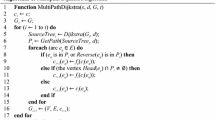Abstract
Recent advances in Wireless Mesh Networks (WMNs) have overcome the drawbacks of traditional wired and ad-hoc networks and now they are seen as a means of allowing last mile communications with quality level assurance in Future Multimedia Systems. However, new routing schemes are needed to provide end-to-end Quality of Service (QoS) and Quality of Experience (QoE) support for delay/loss/jitter-sensitive multimedia applications. The well-known OLSR (Optimized Link State Routing) protocol with ETX (Expected Transmission Count) metric brings many benefits to the path selection process, but has a drawback with regard to queue availability management, which reduces the system performance. This problem is caused when OLSR-EXT control messages are exchanged and the queues of mesh routers along the end-to-end communication path are overloaded. As a result, multimedia-related packets will suffer from loss/delay/jitter and the overall system performance will decrease. This paper proposes the Optimized Link State Routing-Fuzzy ETX Queue (OLSR-FEQ) protocol to overcome the limitations of OLSR-ETX regarding queue availability, QoS and QoE assurance. OLSR-FEQ optimizes network and user-based parameters by coordinating queue availability, QoS and fuzzy issues in the routing decision process as a way of allocating the best paths for multimedia applications. Performance evaluations were carried out with the Network Simulator (NS-2.34) to show the benefits of the proposed solution when compared with existing routing schemes, namely OLSR-ETX, OLSR-FLC, OLSR-MD and HWMP (IEEE 802.11s standard), regarding QoS (unsuccessful packet delivery and throughput) and QoE (PSNR, SSIM, VQM and MOS) parameters.















Similar content being viewed by others
References
Balam J, Gibson J (2007) Multiple descriptions and path diversity for voice communications over wireless mesh networks. IEEE Trans Multimed pp. 1073–1088, August
Bruno R, Conti M, Pinizzotto A (2009) Capacity-aware routing in heterogeneous mesh networks: an analytical approach. In: Proceedings of the 12th ACM international conference on modeling, analysis and simulation of wireless and mobile systems(MSWiM '09). ACM, New York, NY, USA, 73–81
Clausen T, Jacquet P (2006) Optimized link state routing protocol (OLSR)—RFC 3626. http://www.ietf.org/rfc/rfc3626.txt
CordeiroW, Aguiar E, Moreira W, Abelem A, Stanton M (2007) Providing quality of service for mesh networks using link delay measurements. 16th International Conference on Computer Communications and Networks, pp. 991–996
De Couto D, Aguayo D, Bicket J, Morris R (2003) A high-throughput path metric for multi-hop wireless routing. 9th Annual International Conference on Mobile Computing and Networking, pp. 134–146
Dely P, Kassler A, Bayer N, Einsiedler H-J, Sivchenko D (2010) FUZPAG: A fuzzy-controlled packet aggregation scheme for wireless mesh networks, Fuzzy Systems and Knowledge Discovery (FSKD), 2010 Seventh International Conference on, vol.2, no., pp. 778–782, 10–12 Aug
Evalvid (2011) Last accessed, Octuber. http://www.tkn.tu-berlin.de/research/evalvid/
Fall K, Varadhan K (2011) The network simulator—ns-2. Last accessed, Octuber. http://www.isi.edu/nsnam/ns/
Foreman, Paris and News. Last accessed, Octuber 2011. http://www.tkn.tuberlin.de/research/evalvid/cif.html
Gomes RL, Moreira WA Jr, Cerqueira E, Abelém AJG (2010) A QoE fuzzy routing protocol for wireless mesh networks. FMN 1–12
Institute of Electrical and Electronic Engineering (1999) IEEE 802.11, 1999 Edition (ISO/IEC 8802–11: 1999): information technology—telecommunications and information exchange between systems—local and metropolitan area network
Liu L, Zhu L, Chen Y (2010) Research of QoS routing protocol based on delay for wireless Mesh networks, Information Science and Engineering (ICISE), 2010 2nd International Conference on , vol., no., pp. 4650–4653, 4–6 Dec
Mamdami EH, Assilina S (1975) An experiment in linguistic synthesis with a fuzzy logic controller. Int J Man Mach Stud 7(1):1–13
Moreira W, Aguiar E, Abelém A, Stanton M (2008) Using multiple metrics with the optimized link state routing protocol for wireless mesh networks. 26th Brazilian Symposium on Computer Networks and Distributed Systems, May
Serral-Gracia R, Cerqueira E, Curado M, Monteiro E, Yannuzzi M, Masip-Bruin X (2010) An overview of quality of experience measurement challenges for video applications in IP networks. In: Proc. of International Conference on Wired/Wireless Internet Communications (WWIC 2010), Lule – Sweden
Sgora A, Vergados DD, Chatzimisios P (2009) IEEE 802.11s Wireless mesh networks: challenges and perspectives, mobile lightweight wireless systems, lecture notes of the institute for computer sciences. Soc Informat Telecommun Eng Volume 13. ISBN 978-3-642-03818-1. Springer Berlin Heidelberg, p. 263
Winkler S, Mohandas P (2008) The evolution of video quality measurement: from PSRN to hybrid metrics. IEEE Trans Broadcast 54:1–9
Yan H, Perkins D, Velaga S (2010) Design and implementation of CLASS: a cross-layer ASSociation scheme for wireless mesh networks, INFOCOM IEEE Conference on Computer Communications Workshops , 2010, vol., no., pp. 1–6, 15–19 March
Zadeh LA (1965) Fuzzy sets. Inf Control 8
Zhang R, Long K (2002) A fuzzy routing mechanism in next-generation networks. In: Proceedings of IASTED international conference on intelligent systems and control (ISC); October
Acknowledgements
The authors would like to thank the Para State Government (Brazil), FAPESPA, UFPA, REDE TIC, and CNPq for sponsoring this research study.
Author information
Authors and Affiliations
Corresponding author
Rights and permissions
About this article
Cite this article
Pinheiro, B., Nascimento, V., Lopes, R. et al. A fuzzy queue-aware routing approach for wireless mesh networks. Multimed Tools Appl 61, 747–768 (2012). https://doi.org/10.1007/s11042-011-0933-8
Published:
Issue Date:
DOI: https://doi.org/10.1007/s11042-011-0933-8




